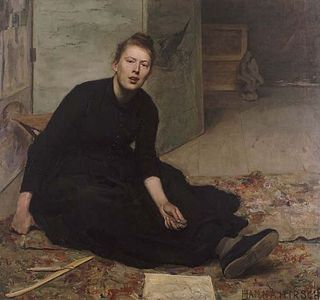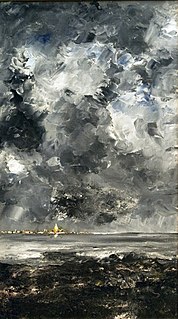 W
WBertha Wegmann Painting a Portrait is a 19th-century painting by Jeanna Bauck, showing Bertha Wegmann at work in their joint studio in Munich. It was acquired by the National Museum in Stockholm in 1930 from Ms. Toni Agnes Möller-Wegmann as a gift. The two artists also lived in the studio depicted in the painting. Painted using oil on canvas, the painting measures 100 by 110 centimetres.
 W
WBoys Drawing is an 1864 oil on canvas painting by the Swedish artist Sofie Ribbing in the collection of the Gothenburg Museum of Art.
 W
WBreakfast time or Frukostdags is an oil painting completed in 1887 by the Swedish artist Hanna Pauli (1864–1940). It measures 91 by 87 centimetres and currently belongs to the Nationalmuseum which bought it in 1910. The image shows a dining table standing in a garden. Breakfast time is one of the museum's most popular images, mentioned as one of the real pearls of the 1800s.
 W
WThe Cemetery is an 1877 painting by Swedish artist Carl Fredrik Hill. The painting is currently on display at the Malmö Art Museum in Sweden.
 W
WDancing Fairies is a painting by the Swedish painter August Malmström (1829–1901). The painting depicts fairies dancing above the water, in a moonlit landscape.
 W
WDeath playing chess is a monumental painting in Täby Church located just outside Stockholm, Sweden. It was painted around 1480–1490, by the Swedish medieval painter Albertus Pictor.
 W
WThe Dying Dandy is a painting by Nils Dardel, painted in 1918, and today it is part of the collection of Moderna Museet in Stockholm.
 W
WInterior of a Studio in Paris is an 1886 oil on canvas painting by Eva Bonnier, measuring 41 by 32 cm and showing a sculpture of a young boy in her studio on Rue Humboldt in Montparnasse - she lived in the French capital from 1883 to 1889. It is in the collection of the Nationalmuseum in Stockholm, to which it was given in 1910 by Karl Otto Bonnier.
 W
WKing Gustav III of Sweden and His Brothers is an oil painting by the Swedish portrait painter Alexander Roslin showing Gustav with his two brothers, Prince Frederick Adolf and Prince Charles, later Charles XIII of Sweden. Frederick is standing, Gustav is sitting to the left, and Charles is to the right. The painting is in the collection of the Swedish National Museum.
 W
WThe Lady with the Veil, The Lady with the Fan, or The Veiled Lady is a 1768 oil-on-canvas portrait by Alexander Roslin of his wife Marie-Suzanne Giroust in Bolognese dress. The work was mentioned in an inventory from Österbybruk as Portrait of the One-Eyed Woman; it is now in the Nationalmuseum in Stockholm under its current title. It featured in the 1972 Swedish series of stamps Gustaviansk konst.
 W
WOur Daily Bread is a watercolor painting executed c.1886 by the Swedish artist Anders Zorn which is in the collection of the Nationalmuseum in Stockholm, Sweden.
 W
WPortrait of Venny Soldan-Brofeldt is an oil painting by Hanna Pauli from 1887.
 W
WThor's Fight with the Giants is an 1872 painting by the Swedish artist Mårten Eskil Winge. It depicts the Norse god Thor in a battle against the jötnar. The thunder god rides his chariot pulled by the goats Tanngrisnir and Tanngnjóstr, wears his belt Megingjörð and swings his hammer Mjölnir. The painting was made using oil on canvas, has the dimensions 484 x 333 centimeters and belongs to Nationalmuseum in Stockholm.
 W
WThe Town is a 1903 oil painting by August Strindberg. It is shown at the Nationalmuseum in Stockholm.
 W
WVädersolstavlan is an oil-on-panel painting depicting a halo display, an atmospheric optical phenomenon, observed over Stockholm on 20 April 1535. It is named after the sun dogs appearing on the upper right part of the painting. While chiefly noted for being the oldest depiction of Stockholm in colour, it is arguably also the oldest Swedish landscape painting and the oldest depiction of sun dogs.
 W
WValdemar Atterdag holding Visby to ransom, 1361 is a historical painting by the Swedish historical painter Carl Gustaf Hellqvist (1851–1890).
 W
WVattenfall i Småland is a 19th-century oil painting by Swedish painter Marcus Larson. Painted in 1856, it has been characterized as a typical example of the Düsseldorf school of painting.